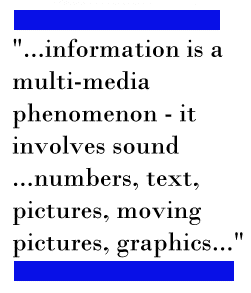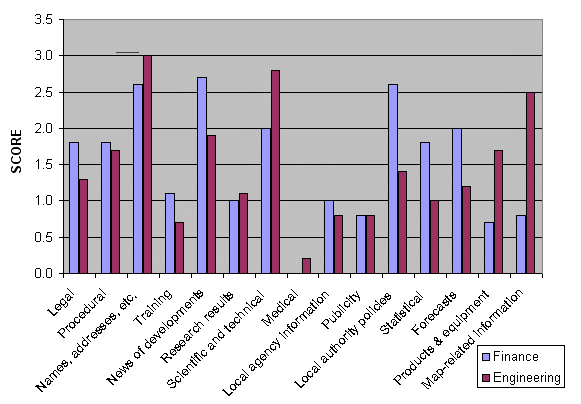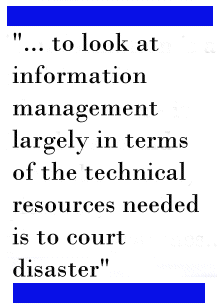Information management
Professor T.D. Wilson
Department of Information Studies
University of Sheffield
Sheffield
S102TN
England
Introduction
Marc Porat [1] who has devoted a good deal of research to the size and scope of the 'information sector' of the US economy, has noted that:
"The Paperwork Commission estimates that about $15 billion is spent by the Federal Government in processing paperwork... the printing bill for federal forms is about $1 billion per year; another $1 billion is spent on directives accompanying the forms; and another $1.7 billion is spent to file and store forms."
""...the State of Maryland refused to accept a $60,000 grant from HEW for a consumer education program because the cost of completing the necessary forms would chew up about $45,000.""
""An oil company spent $17 million and used 475 full-time workers to file government reports other than taxes.""
The point Porat is making is clear: generating and organising information are activities that cost money, and the scale of information generation for organizations dealing with central government in the USA is such as to constitute a serious burden not only for themselves, but also for government.
Porat's essay is to be found in an interesting collection of papers edited by Horton and Marchand called Information management in public administration [2]. The book comes at a tune when the term 'information management' is becoming a 'buzzword' on both sides of the Atlantic and it is of relevance to ask, "Why now?"
The answer is fairly straightforward: the development of information technology and its use in offices in all kinds of organisations has drawn attention to the fact that the creation, transmission, organisation and use of information cost money. Information has become recognised as a resource in organisations: they have spent considerable sums on the capture of data relating to their operations and have been involved in significant capital expenditure in information technology to organise and use the data. In the USA added emphasis to the idea of information management was given by the so-called Paperwork Act of 1980 [3] which represents an attempt to curb government's demands upon business and industry for reports and returns and an attempt to curb also the generation of government paperwork.
Information management is not a simple matter of the right computer and the appropriate software for handling data, however. There are some complexities of information use in organisations and a multi-disciplinary or team approach is necessary for the effective management of information. Furthermore, the user of information must claim a significant role in its management and refuse to be satisfied with systems devised on the basis of other people's simplistic perceptions of the users' needs.
The nature of 'information'
What do we mean by the word 'information'? Most people talk in terms of information as a 'stuff' — some container of data or other symbols. However, there is theoretical argument in information science about whether we should regard information as a 'stuff' or as a 'process' and about what kind of definition is most useful for the design of information systems and services. We might think, for example, that managing a 'stuff' is easier than managing a process.
What kind of process could 'information' be? This is where problems begin because the process must be an individual cognitive process and, therefore, inaccessible to direct observation by others. Under this kind of definition 'information' is gained by an individual when some change occurs in his or her knowledge of something. Now this is useful in the simple sense of drawing attention to the fact that when we present information (the stuff) to a person it is necessary to pay attention to the person's existing state of knowledge if the information process is to take place efficiently and effectively. It is also pertinent to the problem of determining the benefits of 'information' since, clearly, no benefit can occur unless some useful change in the state of knowledge of the person occurs.
Another definition of 'information' is: that which aids decision-making. Useful again, because it draws attention to the fact that some of the 'stuff' we give decision-makers actually hinders decision-making. We cannot take for granted that the giving of information is useful in itself: there is such a thing as 'information overload'.
In fact, one could take practically any definition of 'information' and find it useful to some degree. It is important, however, not to take a single definition and ask it to serve all purposes in guiding systems design: it is necessary to think of information as both stuff and process.
Information resources
When we use the term information resources we are usually thinking of the 'stuff' of information. Very often, the idea of information resources seems to be restricted, usually because of the overwhelming significance of one type of information for the individual, work group or organisation.

For example, for the insurance company, client files are an important information resource, just as files on clients of another kind are important for social services departments in local government. For the research chemist, however, published research is 'information'; for the production manager of a company it is production data; for the company accountant it is financial records; for the salesman it is names and addresses of potential buyers—and so on. And for practically everybody the most important resource is—other people. Just about every study of the information needs of different groups, from researchers to teachers to local government officials points to the fact that if you want to know something the first thing you are likely to do is to ask someone whom you think may know already. And curiously, although that is very common behaviour, almost no organisation sets out to record its 'knowledge holders' although more may have been spent on ensuring that the individuals possess the relevant knowledge than is ever spent on collecting data, and although a great deal of time is spent by newcomers to an organization finding out 'who knows what'.
It is possible, of course, to find various ways in which 'information' can be categorised and Figure 1 suggests one way.
|
Internal information resources People—oral communication Correspondence—mail, memoranda Data—Records—Files on activities, operations, personnel, etc. Graphic materials—maps, charts, diagrams, etc. External information resources People outside the organization Internal information resources of other organizations 'Published' information—books, journals, reports, etc. Mass media—news Electronic databases and data banks |
Even if this list is incomplete it is enough to draw attention to two things: first, the potential importance of information which is produced outside the organisation, and secondly, the fact that 'information' is a multi-media phenomenon—it involves sound (e.g., voice), numbers, text, pictures, moving pictures, graphics, and so on. This fact is recognised in the ESPRIT programme which is devoting much attention to ways of integrating the computer storage and manipulation of these different media.
Different strokes for different folks
Whether information is a stuff or a process the essential fact is that it serves people in organisations in the performance of their tasks—and the stuff, and the processes whereby it is obtained and used vary from person to person, from task to task, and from level to level in the organisation.
An 'information requirements' study is an essential part of any strategy for information management and, such a study must use a wide definition of information resources. Clearly, it will not be possible to control all resources (particularly as some external resources that would be desirable will not be accessible) but a requirements study should examine all needs, not just those that are satisfied already by systems within the organisation.
On the basis of existing work in information science in the area of information needs we can hazard a guess that a requirements study will reveal a very complex situation. For example, Figure 2 (based on an observational study of twenty-two social workers and social service department managers and administrators) shows the types of written documentation which passed across their desks in the course of an ordinary working week.
| Type of written information | Communication 'events' | |
|---|---|---|
| N | % | |
| Legal information | 25 | 2.0 |
| Procedural information | 100 | 7.9 |
| Training information | 21 | 1.7 |
| Central govt. & other statistics | 9 | 0.7 |
| Internal statistics | 44 | 3.5 |
| Client records, referrals, etc. | 266 | 21.0 |
| Internal personnel/financial information | 274 | 21.7 |
| News of developments in social work | 133 | 10.5 |
| Research in social work | 30 | 2.4 |
| Reports on experience or ideas | 69 | 5.4 |
| More than one of the above | 188 | 14.9 |
| Other | 105 | 8.3 |
| Total | 1,264 | 100.0 |
When 151 people in the same organisations were questioned about the frequency of their needs for information in a similar range of categories the result was that shown in Figure 3. It is of interest to note that the frequency of occurrence of document types does not necessarily equate with perceived frequence of need for access to such documents.
| Information type | Modal responses & % respondents giving modal response | |
|---|---|---|
| Mode | % | |
| Legal information | Weekly | 33 |
| Procedural information | Weekly | 35 |
| Names, addresses, tel. nos., etc. | Daily | 80 |
| Training information | Less than monthly | 48 |
| Central govt. statistics | Less than monthly | 50 |
| Internal statistics | Less than monthly | 50 |
| Client records, etc. | Daily | 53 |
| Personnel/financial information | Less than monthly | 33 |
| News of developments in social work | Weekly | 48 |
| Research | Less than monthly | 40 |
| Reports on experience & ideas | Monthly | 36 |
However, we must be careful about aggregated information of this kind: tasks and people differ, even within the same job category. Consider, for example, the two people represented by the job descriptions (offered by themselves) each of whom had the same job title of Assistant Planner (Figure 4).
| Self-descriptions of roles |
|---|
| Assistant County Planning Officer A |
| 1. Preparation, monitoring and review of structure plans for the county. |
| 2. Coordination of public transport within the county. |
| 3. Providing information and data to other departments, public and private bodies and individuals, relating to planning, social, economic and environmental matters. |
| 4. Liaison with public agencies on questions of strategic planning policy. |
| Assistant County Planning Officer B |
| 1. Historic buildings and conservation areas. |
| 2. Industrial and other archaeology. |
| 3. Countryside planning and management. |
| 4. Coastal planning and management. |
| 5. Landscape planning, management and ecology. |
| 6. Environmental projects. |
| 7. Nature conservation. |
| 8. Tree and woodland management. |
| 9. Derelict land reclamation. |
| 10. Gipsies. |
| 11. Tourism and recreation. |
One can see very readily that these two people will want rather different kinds of information—and the same applies on the level of departments within an organisation. In this case, two departments in a local authority (see Figure 5 below).

And the lesson to be learned from this? Systems (particularly computer systems) like stereotypes, but people differ. [6]
Towards an information management strategy in organisations

There has been little emphasis on information technology in this paper, quite deliberately—the journals are full of papers on that topic by others far more competent than this author. But to look at information management largely in terms of the technical resources needed is to court disaster. Information management calls for the development of a strategy within the organisation which will encompass the user, the information resources and the available and appropriate technology.
A number of questions must be asked in developing a strategy:
- What information do people need to help them to do their jobs?
- Are they getting that information? If so, at what cost? If not, what is the cost?
- What priorities exist to guide who should get what information?
- What methods of acquisition, storage, organisation, and delivery are used? At what cost?
- What alternatives exist for each of these processes? What do they cost?
- What systems would be best? What will they cost?
- What is the appropriate balance between manual and computer systems?
Evolving a strategy based on these questions means that a new look must be taken at information and its role in organisations—for as long as people predominate as information processors there is a tendency to take information for granted. As soon as capital investment is needed and some of the costs of information processing are more readily identifiable as a result, new questions begin to be asked. Unfortunately, many of the questions have no ready-made answers, because taking information for granted means that none of the relevant data is collected so that, for example, discovering the true costs of present systems can prove to be very difficult indeed.
Now where is the 'electronic library' in all of this? Is it reasonable to think of such a thing as a physically-located unit with special responsibilities for the acquisition and organisation of a limited range of document types and online modes of access to bibliographic and data files? Or is the 'electronic library' more likely to be just that combination of electronically-accessible resources that happen to be located somewhere in the organisation? Access to information is going to be distributed— is already distributed; individuals with the responsibility for generating information for special purposes will be creating their own electronic files (some personal, some generallyaccessible). With distributed resource generation, distributed computing power, and networks as commonplace phenomena in organisations the 'library' in the traditional sense no longer needs to exist.
Does this foreshadow the end of the information scientist, then? If information scientists and information science education cannot change to meet the challenge of the 'distributed electronically accessible library' (!) the answer to this question must be 'Yes'. However, there will remain a role for information science and it is important to note how much more widely this term is being adopted and how many advertisements are now being seen for information system analysts, information managers, information system managers, and so on, where only one or two years ago the word 'computer' was seen instead of 'information'.
An information policy and an information strategy are going to be key management issues in modern organisations as the installation of information technology gains ground. It would be better to evolve the policy and the strategy before implementing the technology—and as a moral here is a true story:
| In a major company, known to be to the fore in the implementation of office automation, decisions had been taken to base the implementation on IBM equipment, a mixture of mainframe computers, IBM PCs, and IBM word-processors. A total of approximately 2,000 terminals was to be installed. Having taken this decision, the organisation then established a 'Data resources working party' to discover what data existed which could be incorporated into the new system—the working party has now almost reached the point of defining itself as the 'Information resources working party'—but not quite! |
An earlier version of this paper was presented at the Office Technology Seminar in July 1984, organised by the Central Computer and Telecommunications Agency, H. M. Treasury. This version was originally published in The Electronic Library, 3(1), 1985, 61-66.
References and notes:
[1] M. U. Porat, The public bureaucracies, in: F. W. Horton & D. A. Marchand, ref. 2 below, pp. 16-27.
[2] F. W. Horton & D. A. Marchand, editors. Information management in public administration Arlington, VA.: Information resources press, 1982.
[3] U.S. Public law 96-511. 1980 [Paperwork eduction act.]
[4] Project INISS has an extensive bibliography, available from the author. The final report was published as: T. D. Wilson & D. R. Streatfield. You can observe a lot...: a study of information use in local authority social services departments. Sheffield: University of Sheffield, Postgraduate School of Librarianship and Information Science, 1980. A shortened version was published as: D. R. Streatfield & T. D. Wilson. The vital link: information in social services departments. Sheffield & London: University of Sheffield Joint Unit for Social Services Research & Community Care, 1980.
[5] Project LOGI resulted in two 'self-help' manuals: G. Francis, C. Mullings & T.D. Wilson. A manual for the evaluation of current awareness bulletins. London: British Library R. & D. Department, 1981. (BLRDD Report No. 5584) and C. Mullings, G. Francis, & T. D. Wilson. A manual for the investigation of local government information needs. London: British Library R. & D. Department, 1981. (BLRDD Report No. 5585)
[6] Organisations of the same type and of apparently identical functions may also vary in their information management practices. For example, see: T. D. Wilson & I. M. Masser 'Environmental monitoring and information management in County planning authorities', in: H. J. Dietschmann, editor. Representation and exchange of knowledge as a basis of information processes: proceedings of the Fifth International Research Forum in Information Science (IRFIS 5), Heidelberg, F.R.G., September S-7, 1983. Amsterdam: North-Holland, 1984
.How to cite this paper
Wilson, T.D. (1985) Information management. The Electronic Library, 3(1), 61-66 [Available at http://informationr.net/tdw/publ/papers/1985InfoMgt.html]